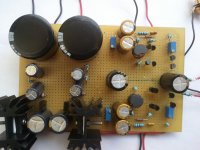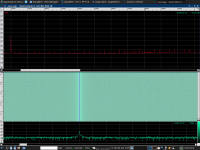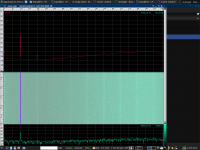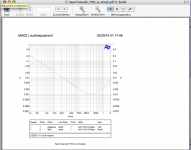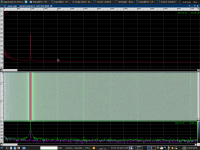Hello Keantoken,
I built this buffer (P2P) with capacitance multiplier power supply on left hand side and 2 channels of buffer on the right. It sounds pretty good with most improvement felt in the high frequencies which are reproduced very well. It may be due to my cables causing some reduction in high frequencies. Need to listen more.
Thanks
I built this buffer (P2P) with capacitance multiplier power supply on left hand side and 2 channels of buffer on the right. It sounds pretty good with most improvement felt in the high frequencies which are reproduced very well. It may be due to my cables causing some reduction in high frequencies. Need to listen more.
Thanks
Attachments
It is a very good sounding buffer for sure. We just have to sort out that distortion issue at higher amplitudes. I mean for the record. I do not care much about super low distortion anyway. Then an AD797 configured for 0dB gain would be the end of the story. That kind of buffer whould measure the measurement equipment ( Audio Precission ).
For example MBL do it that way.
For example MBL do it that way.
Then an AD797 configured for 0dB gain would be the end of the story.
I thought I read somewhere that the AD797 is not easy to implement as a unity gain buffer.
. We just have to sort out that distortion issue at higher amplitudes. I mean for the record. I do not care much about super low distortion anyway.
Would you explain what you mean ?
Does it produce audible distortions with 1v input ?
I can not hear better then 1% 2nd harmonic and 0.1% 3rd.
So, no, it does not sound distorted in any way.
The AD797 can be made as a stable buffer easy.
No, i did not direct compare the Kean to my floating cascode buffer but i compared my buffer to the Calvin. The Calvin has more slam and punsh and has a particular way to sound warm but without loss of detail or resolution.
I compared the Calvin against the Kean. Well., Martina may be able to describe that better.
Ricardo, when you see the distortion measurements we made on the Kean buffer i build ( TKD pot, no distortion trim ) it has minimum distortion at 200mV. Advancing the volume the distortion rises.
So, no, it does not sound distorted in any way.
The AD797 can be made as a stable buffer easy.
No, i did not direct compare the Kean to my floating cascode buffer but i compared my buffer to the Calvin. The Calvin has more slam and punsh and has a particular way to sound warm but without loss of detail or resolution.
I compared the Calvin against the Kean. Well., Martina may be able to describe that better.
Ricardo, when you see the distortion measurements we made on the Kean buffer i build ( TKD pot, no distortion trim ) it has minimum distortion at 200mV. Advancing the volume the distortion rises.
Both channels show the same THD and spectrum, so it may have to do with the pot or the batch of transistors used. I used
I've had a used cable TV splitter sitting on my desk for months, and I had the idea to build a Kuartlotron into it. Then I realized it would double as a video buffer. Lol!
Sounds like a good idea anyways, except I'd have to use coaxial interconnects which would be awkward.
I've had a used cable TV splitter sitting on my desk for months, and I had the idea to build a Kuartlotron into it. Then I realized it would double as a video buffer. Lol!
Sounds like a good idea anyways, except I'd have to use coaxial interconnects which would be awkward.
Can you show the measurements ?
What is the input impedance of your soundcard ?
I have a 2-minute 10KHz sine wave measurement I could send by email, but it's a large file.
Here is an image of those 2 minutes averaged in an FFT. The 2nd harmonic can't be measured, and the 3rd harmonics could easily be spectral noise. The Kuartlotron input is subtracted from the output, which is why the fundamental is low.
I don't know what the impedance of my soundcard is, but I suspect it's not very high.
Attachments
The AD797 can be made as a stable buffer easy.
Care to provide a link or a diagram showing a circuit using it as a unity gain buffer?
Thanks...
Okay, I figured out how to get the lowest noise floor on my soundcard. I also made a mistake in calculating THD. H2 is at -96db, so THD is about .0016%. This is at 1V pk-pk input.
While this measurement is more than I've gotten in the past, it's pretty good considering that my Kuartlotron as it's running right now is out of trim because I had to use a higher voltage supply. It may be able to lower it by trimming.
EDIT: Attached FFT.
PS. This is coming from ONBOARD sound on an Asus M5A99FX Pro R2.0 motherboard. Surprising?
While this measurement is more than I've gotten in the past, it's pretty good considering that my Kuartlotron as it's running right now is out of trim because I had to use a higher voltage supply. It may be able to lower it by trimming.
EDIT: Attached FFT.
PS. This is coming from ONBOARD sound on an Asus M5A99FX Pro R2.0 motherboard. Surprising?
Attachments
My experience is in agreement Joachim, and a friend has sternly told me that this buffer sounds great even when it's not working optimally. So while THD is low, that does not seem to be the reason this buffer sounds good.
Still, for those who want to know, here is the FFT after trimming. H2 is at -112db. That is 0.0002%THD at 1V pk-pk input!
So, without trimming you can expect THD around .001-.003%, and after trimming you can expect THD down to .0002%. That matches the simulation very well. I think the path forwards from here is not necessarily to lower THD, but to design the circuit so that it gets lower non-trimmed distortion.
Here's what I did:
1: My power supply is +-12.18V.
2: Adjust R5 so that TP is at 5.9V.
3: Adjust R1 for best THD null, watchingt TP for reference.
4: TP ended up at 4.85V at the optimal trim point.
5: Your trimming results may vary.
Still, for those who want to know, here is the FFT after trimming. H2 is at -112db. That is 0.0002%THD at 1V pk-pk input!
So, without trimming you can expect THD around .001-.003%, and after trimming you can expect THD down to .0002%. That matches the simulation very well. I think the path forwards from here is not necessarily to lower THD, but to design the circuit so that it gets lower non-trimmed distortion.
Here's what I did:
1: My power supply is +-12.18V.
2: Adjust R5 so that TP is at 5.9V.
3: Adjust R1 for best THD null, watchingt TP for reference.
4: TP ended up at 4.85V at the optimal trim point.
5: Your trimming results may vary.
Attachments
Last edited:
Kean,
What is the value of R1 after trimming? I dont have equipment to measure THD but want to know if there is some other way of getting lowest THD without measurement.
Anyway, I listened to it more yesterday and it is very good for sure. High frequency retrieval is amazing (atleast in my setup).
Thanks
What is the value of R1 after trimming? I dont have equipment to measure THD but want to know if there is some other way of getting lowest THD without measurement.
Anyway, I listened to it more yesterday and it is very good for sure. High frequency retrieval is amazing (atleast in my setup).
Thanks
- Home
- Source & Line
- Analog Line Level
- The Kuartlotron - keantoken's simple error-correction superbuffer
